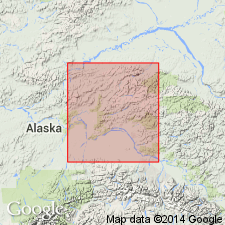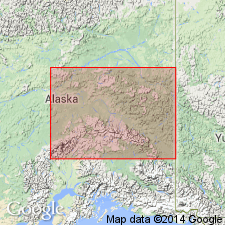
- Usage in publication:
-
- Tatalina group*
- Modifications:
-
- Named
- Biostratigraphic dating
- Dominant lithology:
-
- Conglomerate
- Sandstone
- Graywacke
- AAPG geologic province:
-
- Alaska East-Central region
Summary:
Typically exposed in valley of Tatalina River, Fairbanks quad, east-central AK. Made up chiefly of feldspathic fragmental rocks, including conglomerates, sandstones, and graywackes with slates and some limestones and cherts. Locally includes greenstone consisting of basic tuffs and lavas. Is probably several thousand ft thick. Unconformably overlies Birch Creek schist; in White Mountains underlies limestones of Ordovician to Devonian age. Fossils indicate upper part of group is Ordovician. Lower part may be Cambrian, but group is provisionally referred to Ordovician(?) age.
Source: GNU records (USGS DDS-6; Menlo GNULEX).

- Usage in publication:
-
- Tatalina group†
- Modifications:
-
- Abandoned
- AAPG geologic province:
-
- Alaska East-Central region
Summary:
Volcanic part of Tatalina group of Prindle (1913) is here named Fossil Creek volcanics of Middle Ordovician age. Major part of group is included in assemblage mapped as undifferentiated pre-Middle Ordovician rocks. Name Tatalina group is therefore abandoned.
Source: GNU records (USGS DDS-6; Menlo GNULEX).
For more information, please contact Nancy Stamm, Geologic Names Committee Secretary.
Asterisk (*) indicates published by U.S. Geological Survey authors.
"No current usage" (†) implies that a name has been abandoned or has fallen into disuse. Former usage and, if known, replacement name given in parentheses ( ).
Slash (/) indicates name conflicts with nomenclatural guidelines (CSN, 1933; ACSN, 1961, 1970; NACSN, 1983, 2005, 2021). May be explained within brackets ([ ]).

